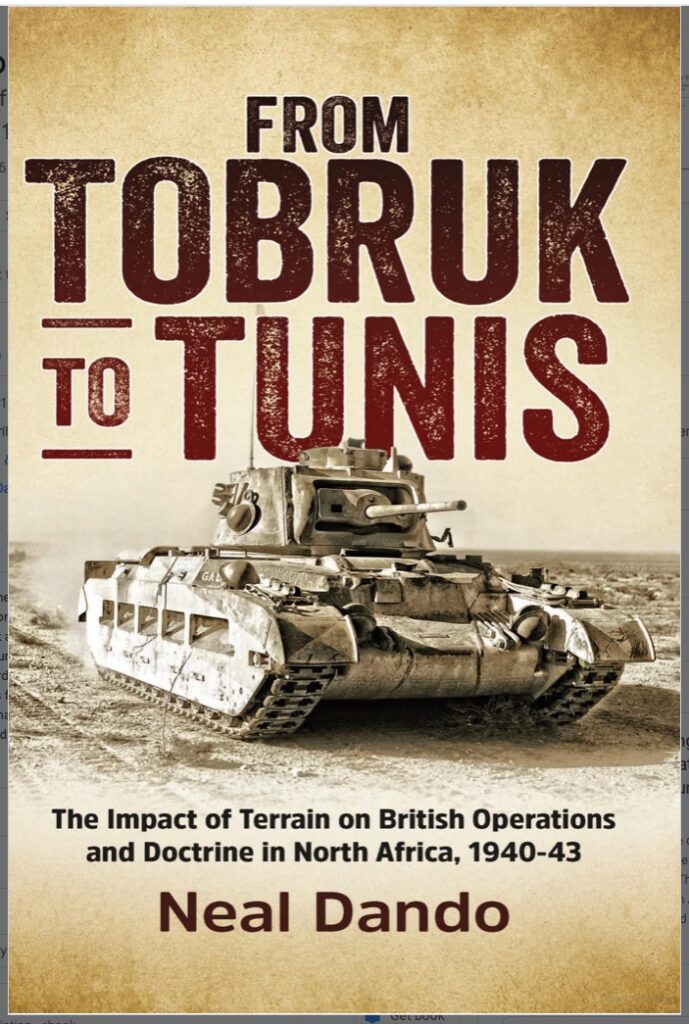
I have just finished reading this short book published by Helion as part of the Wolverhampton Military Studies series. The cover shows the scope. Its main focus is operations of the British Eighth Army from 1941 to 1943. The earlier campaign between British and Italian forces in 1940 is covered in the same level of detail, but conclusions from it are not integrated with the rest of the book. First Army operations in Tunisia are not covered.
The author, Neal Dando, probably had a lot of fun researching this book, going through the (almost entirely British and Commonwealth) primary sources in depth, and a wealth of secondary sources, and appraising the course of the campaigns. However, the book is quite short and focused on the key theme: the impact of terrain on the British approach. His contention is that terrain is not given sufficient attention as one of the factors dictating the course of events, compared to such things as tactics and leadership. It’s a long time since I have read anything much on these campaigns, so I can’t judge this contention for myself. I think there’s something in it – but it is problematic. Firstly, all historians surely comment on the desert terrain, and suggest that it lent a particular character to events, even if they can be a bit vague on details. Second since much of the function of leadership and tactics is about the use of terrain, it is hard to separate it out as factor on its own – and a bit false.
Still I am a big believer in the importance of terrain in warfare – and feel that it is often not given the attention it deserves. This is reflected in many wargames, which tend to over-simipify and abstract away terrain features. Time and again when studying battles in detail (mainly Napoleonic ones) I have found that terrain factors neglected by historians explain much. One example was how a recent historian suggested that the French grand battery at Waterloo should have blasted away the strongpoint at La Haye Sainte. In fact the lay of the land made that pretty much impossible. And I have often read that it is wrong to think of the Western Desert in WW2 as being entirely flat. It featured many minor undulations, which could have a critical impact on events. You could place antitank guns in hollows and wait for the approaching tanks to be silhouetted on the ridgeline as they approached, for example. How well this is reflected in wargames I wouldn’t like to say – I have played very few desert-based WW2 scenarios. The exception have been some quick club games played on a flat table.
I bought this book as I am trying to put together some rules for my 1943 project, featuring British forces in Tunisia, Sicily and Italy. It has always been clear that terrain had a huge impact on these campaigns, so I was looking for ideas on how this should be reflected. I was pretty disappointed. I understand why Mr Dando does not want to give a detailed narrative of the battles – but I was hoping for something rather more systematic on the analysis of terrain impacts. Something like a description of the different impacts, and the part each of these played in each of the battles. There are brief terrain descriptions, but nothing very systematic on the narrative. There are a few maps, but representation of terrain on these was pretty thin. In fact I’m not actually sure he familiarised himself directly with the terrain, rather than simply relaying what the various primary documents, and a few secondary ones, say. He seems to jump straight to his conclusions with a “take my word for it” approach. On top of that, the book is riddled with minor editing errors (of the sort you will doubtless find on this blog, I’m afraid, but shouldn’t on things you pay money for), including one map mislabelling a German division as Italian. This is the rule rather than the exception with modern specialist publishing, however.
So what were the main impacts? Going was variable, affecting the ability to move different types of forces (one area could be traversed by tracked vehicles but not wheeled ones, for example) – including some steep slopes and cliffs. Terrain could offer a degree over cover (e.g. the use of hull-down positions), but was generally notable for the lack of it; in some places it was impossible to dig in because the ground was too rocky. Concealment was important factor using undulations, wadis and depressions – and there is related aspect of the usability of heights as vantage points for use by direct fire, and most especially as observation points for indirect artillery fire. Most of this is standard wargames fare – though wargamers often fail to bother with gentle terrain undulations. But artillery is usually less well thought about in this era. And yet it’s clear from this book that it was critically important – with battles often resolving around the possession of heights for use by FAOs. This was obviously the case with the mountain warfare in Tunisia – where the entire campaign revolved around the issue – as my reading of the account of Longstop Hill showed.
This book, though, gives me very little data to flesh this out. At one point it mentions a tank attack suffering at at 2,000 yards from enemy lines from artillery fire (6in Italian coastal artillery, apparently). I guess it would not be too hard to make out approaching vehicles at that sort of range, with the usual optical equipment. But fall of shot would have been much harder.
So an interesting but ultimately disappointing book.